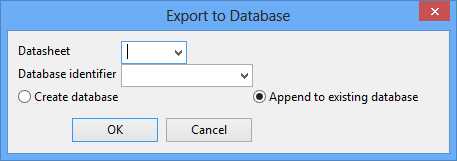Export To Database
Export holes to a database
The Export to Database option to store hole data, including the intersections of those holes with grids and/or triangles, in a database. Once stored in the database they can be displayed and manipulated.
To use this option, the holes need to be displayed on the screen.
The database does not need to exist prior to using this option. The underlying design must, however, exist (created in Isis). This design is a standard lithological (drillhole) design. The system uses the synonyms in the design to decide where to put the data. Your design must at least contain the following tables
HOLEID
,
SURVEY
and
GEOL
with fields and synonyms as described below. Note it is not necessary to use the same field and table names.
Note
- Ensure that the holes are named before exporting otherwise you will get a warning message for each unnamed hole and if you choose to continue, then you will get duplicate keys with names "??????". You can use the Automatics Naming or the Interactive Naming options to name the holes. You can use the Annotate Holes option to display the names.
-
The Create DSR check box is only displayed when you have selected to export to a library style database and the environment variable
NO_ISIS_HEADERhas been set. A dialog box will be displayed after you have completed the Export to Database panel that will allow you to create adsrdatabase. If you are creating a headered database (Isis file database), then the design will include the desurvey information. Refer to Isis > New Design for information on creating a headered design.
Instructions
- Select Open Pit menu
- Select Hole Design submenu
- Select Export To Database option
The following panel displays.

Export to Database panel
Data sheet name
Enter, or select from the drop-down list, the design name (
<dsn>
).
Optional Database identifier
Enter, or select from the drop-down list the database identifier. The optional database identifier (
<odi>
) allows you to differentiate between databases created from this design.
Create database
Select this option to create a new database. By default the database will be named
<proj><odi>.<dsn>.Isis
where
<proj>
is the project code,
<odi>
is the optional database identifier and
<dsn>
is the design (datasheet) name.
If, however, the environment variable
NO_ISIS_HEADER
has been set, and you have selected a library dictionary design, then the database will be named
<proj><odi>.<dsn>.
In both cases the database is stored in your current working directory.
Append to existing database
Select this option to append the exported data to an existing database.
Select OK.
The Multiple Selection box is then displayed. This to select the holes to be exported by category. Right-click when you have finished selecting holes. Depending upon your selection method you may need to cancel more than once. However, if you have chosen to export to a library style database, and you have set the environment variable
NO_ISIS_HEADER
, then you will first be prompted to create a DSR database (downhole survey
.dsr
database) after export.
Creating a DSR database allows holes that are at an angle to be displayed correctly.
Once the holes have been selected, the data is exported. If you have chosen to create a DSR database, then a window is spawned in which the export process runs.
Use Isis to view the database.

